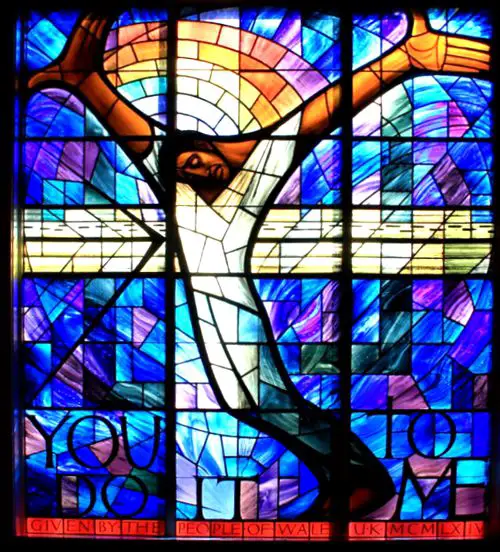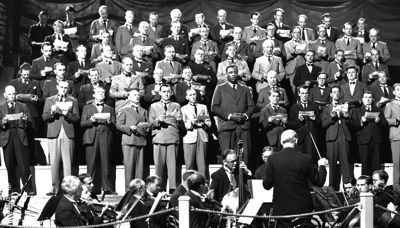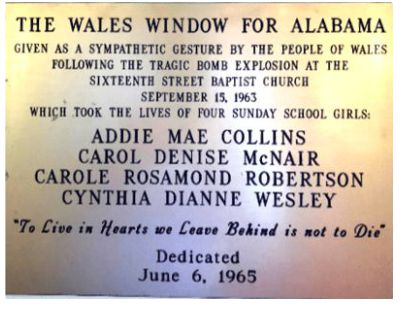Stained Glass Commemorates the 16th St Baptist Church bombing
How does the ancient art of stained glass intersect with the Black Lives Matter movement? And what is the moving connection between the people of the small principality of Wales and the fight for racial justice in the US?
It was a Sunday morning in 1963 at the 16th Street Baptist Church in Birmingham Alabama when four Ku Klux Klan members exploded 15 sticks of dynamite under the steps on the east side of the church. About 200 parishioners were in the building when the bomb exploded and four young black girls were killed.
Only days before the attack, Dr. Martin Luther King Jr had made his famous “I Have a Dream” speech. The bombing of the 16th Street church felt like a vicious riposte.
The outrage of this cowardly act was not confined to the US. Far across the ocean, a stained glass artist called John Petts from the small village of Llansteffan in Wales was said to have been horrified “as a father and as a craftsman” by the news.
Petts immediately began a petition to raise funds to manufacture a replacement stained glass panel to commemorate the murdered girls. He deliberately refused to accept corporate and government funding, specifying instead, that the money must be raised in small donations (not to exceed “half a crown” – which is the equivalent of about 15 cents in today’s money). This way the window could be said to have been donated by the people of Wales.

The resulting panel was considered controversial (and even blasphemous) when it was installed in 1965 because it featured a black Jesus – a depiction never previously seen in the racist Deep South.
Petts’ rendering of a black Christ has become one of the Civil Rights Movement’s most iconic pieces of art. The right-hand pushes against prejudice and hatred, while the left appears to offer reconciliation. A superincumbent rainbow, represented racial diversity, while Petts added the words “You do it to me”, from Mathew 25:40 elaborating the Christian message of brotherly love: “Truly, I say to you, as you did it to one of the least of these my brothers, you did it to me.”
In particular, John Petts was careful to draw the face of Christ, not only with black pigment but also with characteristic African American features – making the image doubly recognizable to the congregants.

The current Pastor, Reverend Arthur Price, has memorably described the window as follows:
“The boldness – in the USA – of having a black Christ speaks volumes. For the African American community that’s not a stretch at all, but for many people in the white community during that time, to say that Jesus Christ was black and of African descent would be blasphemous,”
“But I think the major message we try to take out of the window is not so much identifying Christ’s colour but knowing that Christ identifies with us.
“To the white community this is that the Jesus you love identifies himself with the African-American community, so you are really crucifying him again when you persecute someone who does not look like you.”
For more information on how abstraction can increase the interest and excitement of a stained glass panel – see this “Guide to the design of abstract stained glass.“
BBC documentary features Wales Window
A memorable documentary, presented by Gary Younge, describes how the gift of many strangers provided succor to an embattled parish community and gave them the faith to walk proudly once again, but it also guaranteed that a small part of the Deep South remains – forever – a friend of the principality of Wales.
A Black Life that made a Big Difference in Wales
In 1929, Paul Robeson the famous concert artist, stage and film actor, and later black activist was starring in a legendary production of Show Boat in London. Returning from a performance he became aware of mellifluous male voices approaching along the street. He paused, amazed by the perfect harmonization, and then by the discovery that the singers were workers, carrying protest banners as they sang.

By chance, he’d run into a group of Welsh miners from the Rhondda valley. They were the relics of the great working-class movement engaged in the general strike of 1926 and had walked all the way to London looking for ways to feed their families.
By then, Robeson was a wealthy international star but he immediately felt a kinship with these underprivileged workers – remembering his own experiences enduring racism.
He marched with the protest and then he leaped onto the steps of a city building to sing Ol’ Man River and a selection of spirituals to entertain and encourage his new friends.
Afterward, he gave a generous donation enabling the miners to take the train back home to Wales, in addition to food and clothing.

This chance encounter began a long and moving relationship between Paul Robeson and the Welsh Miners shaped by the danger of mining life: the long hours and low wages, and also the disasters that decimated mining towns. In 1934, a coal mine in Caernarfon caught fire, creating an inferno killing over 200 men. At once, Robeson established a fund for the orphans and children of the victims – an important donation monetarily, but far more significant as a gesture of solidarity.
This was why Wales remembered Robeson. He was by then one of the world’s biggest stars and yet he demonstrated that he cared deeply for people in an impoverished and struggling Welsh mining community.
All you need to know about art glass
Commissioning stained and etched glass
- Stained glass designs from Artistry in Glass
- How to commission a stained glass window – complete advice
- How to commission an etched glass window
- How to choose the best stained glass design
- Etched or stained glass – which is better for your home?
- How much does stained glass cost?
- How much does etched glass cost?
Technical information
- Is leaded glass dangerous? Learn the facts.
- How to replace broken patio table glass
- Plexiglass and glass – what are the pros and cons?
- What is plexiglass used for?
- What costs more – glass or plexiglass?
- Preservation of stained glass in churches & synagogues
- How does stained glass get colored? learn from an expert!
- Is your broken stained glass panel worth repairing?
- How to protect stained glass in religious buildings
- How to care for and clean stained glass
- How to repair cracked stained glass
- What is Dalle de Verre?
- How to repair Dalle de Verre
- What to do about bowed & sagging stained glass
- How to care for a stained glass skylight
- Can my stained glass lampshade be repaired?
- What is the difference between sandblasting & etching?
- Obscure and frosted glass – all you need to know!
- How to save money when buying glass
- Glossary of important terms used in decorative glass
- 14 Ways to sell stained glass
- What is imitation or faux stained glass?

